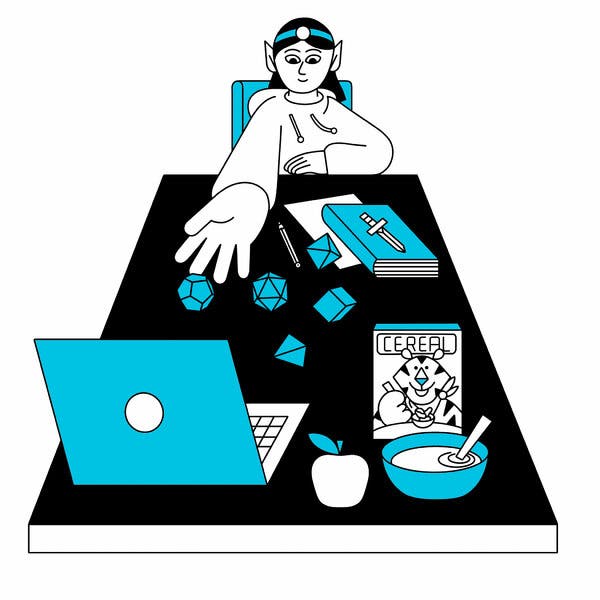#masthead-section-label, #masthead-bar-one { display: none }At HomeFall in Love: With TenorsConsider: Miniature GroceriesSpend 24 Hours: With Andra DayGet: A Wildlife CameraAdvertisementContinue reading the main storySupported byContinue reading the main storyEscape Your Reality With Role-Playing GamesLet the good times roll, as old-school tabletop R.P.G.s have taken off online.Credit…Andrea ChronopoulosMarch 6, 2021, 11:41 p.m. ETRecently, a wizard, a druid, a cleric, a ranger, an artificer and a couple of bards met on Zoom. The bards fought. The druid baked cookies. The cleric, wearing nifty resin dragon horns, took hallucinogenic mushrooms. Together they explored candy-coated barracks, searching for an elusive ; cat jokes crowded the chat.This was an average evening for Mike Sell, a professor of English at Indiana University of Pennsylvania who moonlights as an online game master. On Tuesdays, he gathers friends, colleagues, partners and kids and has them ramble, remotely, through his role-playing game, Curse of the Sugarplum Fairy, a madcap riff on “The Nutcracker” and “Charlie and the Chocolate Factory.” Tagline: “Who can take a rainbow and wrap it in a scream?”Modern role-playing games debuted in the mid-1970s, when Gary Gygax and Dave Arneson invented Dungeons & Dragons. The form has since proliferated — if you can imagine a genre (western, mystery, sci-fi) or a peril (zombies, rogue A.I., chthonic gods), it has probably inspired a game. A hybrid of theater, make-believe, board games and fan fiction, R.P.G.s encourage players to create a story collaboratively as they play.“Tabletop role playing is the most powerful, most versatile form of interactive narrative we have by a mile,” said Nicholas Fortugno, who directs the digital game design program at Long Island University. “Nothing touches it.”R.P.G.s have always been a relatively niche hobby, which is understandable. A typical session involves considerably more effort and imagination than, say, Scrabble. And who dresses up for Monopoly? But when lockdowns made in-person activities risky, these games, began to proliferate online, attracting new players and reviving interest among veteran, dice-clutching hands.Not your nerdy teenager’s Dungeons & Dragons.Last March, when rolling lockdowns began, Roll20, one of many sites that host R.P.G.s online, experienced so many new-user requests (an 840 percent spike, in fact) that its servers assumed it was some kind of cyberattack, said Dean Bigbee, the site’s chief operating officer. Within a year, the site has added three million new users, for a total of eight million. Representatives of similar sites like World Anvil and Role Gate also reported surges.The revenue of Dungeons & Dragons, which still commands the largest market share of R.P.G.s, grew by 33 percent in the past year. Usage of its dedicated website, D&D Beyond, doubled. “It was always growing, but nowhere near that,” said Ray Winninger, the executive producer in charge of the of Dungeons & Dragons studio. According to Mr. Winninger’s colleague Liz Schuh, the director of product management for Dungeons & Dragons, “Virtual play has exploded.” Which means Zoom is the new finished basement.In a typical game, online or off, the game master will present the players with a situation — an encounter with a kobold, say. Each player decides how his or her characters should respond, often rolling dice to determine the success of each maneuver. As these games are cooperative, not competitive, players don’t vie against one another. (Smack talking? Purely optional.) So this is pandemic-friendly escapism that allows your friends to escape with you. Unless a mind flayer takes them out first.Over the past five years, tabletop R.P.G.s — a designation that differentiates them from immense multiplayer online games like World of Warcraft — have edged a little closer to the mainstream, becoming the kind of hobby a person could now admit to in mixed company. (Thirty-nine percent of Dungeons & Dragons players identify as female.) Vin Diesel, Terry Crews and Drew Barrymore have all outed themselves as R.P.G. gamers, and the actor Joe Manganiello (“True Blood”) hosts a celebrity campaign in his basement. The streaming site Twitch has more than 100 channels devoted to Dungeons & Dragons. Critical Role, a live-play campaign executed by voice actors, has become a YouTube hit that recently raised more than $11 million for an animated special. R.P.G.s have also inspired dozens of podcasts, both fictional and live play, like “The Adventure Zone” and “You Meet in a Tavern.” The Netflix show “Stranger Things” has made Dungeons & Dragons a central theme: The boy characters play the game and use its vocabulary to understand their town’s bizarre goings-on. (You can even buy a “Stranger Things”-inspired D&D starter set.)From the basement to Zoom.Before the pandemic, when people already seemed to live mostly online, tabletop R.P.G.s were seen as a respite from multiscreen life, a more artisanal and analog way to connect. “The ability to get together with friends and put on a show, that’s a pretty amazing experience,” Mr. Sell said.During lockdown, when the ability to get together went away, RPGs stayed. Many of the most popular games had already found a home online. Sites and apps like Roll20, Role Gate, World Anvil, Astral, Fantasy Grounds and D&D Beyond have created platforms to make online play possible. Many have tools — like character generators — that simplify a campaign.R.P.G.s don’t require tactile experience (apologies to those who hand-paints miniatures for their characters), so they adapt well to online play. “Almost everything that happens in Dungeons & Dragons happens in your imagination,” Mr. Winninger said. “It makes the transition to virtual play easier.”If you have Wi-Fi, you’re in, and you don’t even need dice: Wizards of the Coast has a page that will roll the dice for you virtually. Other sites feature game enhancements, like virtual maps, and the ability to sync your game to a selection of creepy music. Want to run your own game? Gather a group on Zoom, Skype or Discord. Don’t have any like-minded friends? Wizards of the Coast released the Yawning Portal, a site that matches players with virtual games. Other sites run message boards and marketplaces that connect individuals with groups and groups with games masters. Newbies can easily find experienced players to show them the ropes and chains and dimensional shackles. After-school programs and local libraries run games catering to children and teenagers.Building a bridge for the social divide.And yet, we lose something when we can’t play in person or share Cheetos. Because R.P.G.s depends on storytelling, the experience dwindles when we’re no longer face to face with our fellow tellers. “It’s all about looking at people in the eye and performing with your body,” Mr. Fortugno said. “When you lose all of that, the game becomes more stilted.”But questing through darkened forests or perilous caves from the comfort of your couch can still thrill. And because R.P.G.s have an inherent structure and turn-taking, they may offer more natural engagement than the average Zoom cocktail hour. Having a mutual goal — maiden rescuing, treasure acquiring, sphere of annihilation avoidance — makes the conversation flow. And players can now meet across the country and across the continents.Avery Alder, a game designer (Monsterhearts 2, Dream Askew) who lives in rural British Columbia, used to host weekly in-person role-playing games in a nearby post-and-beam town hall. The pandemic ended that, but she still plays when work and child care allow, which isn’t often. She argues that maybe we need R.P.G.s now more than ever.“In a year when people are feeling a big, big sense of fear and scarcity and gloom, it’s really important to be imagining other possibilities,” she said. “Even if you’re telling stories about a fantasy world, you’re still telling stories about exploration, connection, hope.”AdvertisementContinue reading the main story
Read more →



